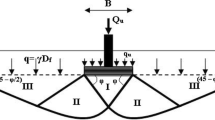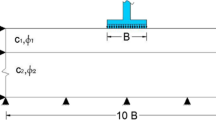Abstract
Numerical investigation of the failure mechanism developed beneath a strip footing resting on non-dilatant cohesionless soil has been investigated in a finite element framework. The observed failure mechanism is manifested in terms of incremental displacement and incremental deviatoric strain patterns. A series of simulation on foundation models were carried out to examine the influence of various factors on the failure mechanism, namely meshing pattern, mesh refinement schemes, soil shear strength properties and embedment of the footing. The numerical outcomes have been verified against sophisticated laboratory investigations available in the literature. The developed failure mechanism is found to be asymmetric and markedly one-directional, the nature being prevalently independent to the variation in the influencing factors. Failure mechanism is found to progressively evolve following a mode-switching phenomenon, exhibiting transition from elastic to plastic deformations at- or near-failure. The deviations of the numerically obtained evolving failure mechanism from the same as pre-assumed in the conventional bearing capacity theories are explored and reported herein.



















Similar content being viewed by others
References
Benmebarek S, Remadna MS, Benmebarek N, Belounar L (2012) Numerical evaluation of the bearing capacity factor N’γ of ring footings. Comput Geotech 44:132–138
Bolton MD (1986) The strength and dilatancy of sands. Geotechnique 36(1):65–78
Cerato AB, Lutenegger AJ (2006) Bearing capacity of square and circular footings on a finite layer of granular soil underlain by a rigid base. J Geotech Geoenv Eng, ASCE 132(11):1496–1501
Chen WF (2010) Limit analysis and soil plasticity. J. Ross Publishing, Noida
Drescher A, Detournay E (1993) Limit load in translational failure mechanisms for associative and non-associative materials. Geotechnique 43(3):443–456
Erickson HL, Drescher A (2002) Bearing capacity of circular footings. J Geotech Geoenviron Eng, ASCE 128(1):38–43
GEO-SLOPE International Ltd (2007) GeoStudio manual for stress-deformation modeling with SIGMA/W 2007: an engineering methodology. GEO-SLOPE International Ltd, Calgary
Hanna A, Rahman AME (1990) Ultimate bearing capacity of triangular shell strip footings on sand. J Geotech Eng, ASCE 116(12):1851–1863
Hanna AM (1982) Bearing capacity of foundations on a weak sand layer overlaying a strong deposit. Can Geotech J 19(3):392–396
Hanna AM, Meyerhof GG (1981) Experimental evaluation of bearing capacity of footings subjected to inclined loads. Can Geotech J 18:599–603
Hansen BJ (1970) A revised and extended formula for earing capacity. Danish Geotechnical Institute, Bulletin No. 28, Copenhagen
Loukidis D, Chakraborty T, Salgado R (2008) Bearing capacity of strip footings on purely frictional soil under eccentric and inclined loads. Can Geotech J 45:768–787
Loukidis D, Salgado R (2009) Bearing capacity of strip and circular footings in sand using finite elements. Comput Geotech 36:871–879
Love JP, Burd HJ, Milligan GWE, Houlsb GT (1987) Analytical and model studies of reinforcement of a layer of granular fill on a soft clay subgrade. Can Geotech J 4:611–622
Manoharan N, Dasgupta SP (1995) Bearing capacity of surface footings by finite elements. Comput Struct 54(4):563–586
Manzari MT, Nour MA (2000) Significance of soil dilatancy in slope stability analysis. J Geotech Geoenviron Eng ASCE 126(1):75–80
Meyerhof GG (1951) The ultimate bearing capacity of foundations. Geotechnique 2:301–332
Meyerhof GG (1978) Bearing capacity of anisotropic cohesionless soil. Can Geotech J 15(4):592–595
Meyerhof GG, Koumoto T (1987) Inclination factors for bearing capacity of shallow footings. J Geotech Eng, ASCE 113(9):1013–1018
Michalowski RL, Shi L (1995) Bearing capacity of footings over two-layer foundation soils. J Geotech Eng, ASCE 121(5):421–428
Michalowski RL, Shi L (2003) Deformation patterns of reinforced foundation sand at failure. J Geotech Geoenv Eng, ASCE 129(6):439–449
Nova R, Montrasio L (1991) Settlements of shallow foundations on sand. Geotechnique 41(2):243–256
PLAXIS (2015) Reference manual for PLAXIS, 2D v2015.02. University of Technology, Delft
Reddy AS, Singh AK, Karnik SS (1991) Bearing capacity of clays whose cohesion increases linearly with depth. J Geotech Eng, ASCE 117(2):348–353
Shiau JS, Lyamin AV, Sloan SW (2003) Bearing capacity of a sand layer on clay by finite element limit analysis. Can Geotech J 40:900–915
Skempton AW (1951) The bearing capacity of clay. Building Research Congress, England
Terzaghi K (1943) Theoretical soil mechanics. Wiley, New York
Van Baars S (2018) Numerical check of the Meyerhof bearing capacity equation for shallow foundations. Innov Infrastruct Solut 3:9
Vermeer PA, de-Borst R (1984) Non-associated plasticity for soils, concrete and rock. HERON 29(3):1–64
Vesic AS (1973) Analysis of ultimate loads of shallow foundation. J Soil Mech and Foun Div, ASCE 99(SM1):45–73
Xiao-Li Y, Nai-Zheng G, Lian-Heng Z, Jin-Feng Z (2007) Influences of non-associated flow rules on seismic bearing capacity factors of strip footing on soil slope by energy dissipation method. J Cent South Univ Technol 6:842–846
Yin JH, Wang YJ, Selvadurai APS (2001) Influence of nonassociativity on the bearing capacity of a strip footing. J Geotech Geoenv Eng, ASCE 127(11):985–989
Author information
Authors and Affiliations
Corresponding author
Rights and permissions
About this article
Cite this article
Acharyya, R., Dey, A. Assessment of failure mechanism of a strip footing on horizontal ground considering flow rules. Innov. Infrastruct. Solut. 3, 49 (2018). https://doi.org/10.1007/s41062-018-0150-7
Received:
Accepted:
Published:
DOI: https://doi.org/10.1007/s41062-018-0150-7




